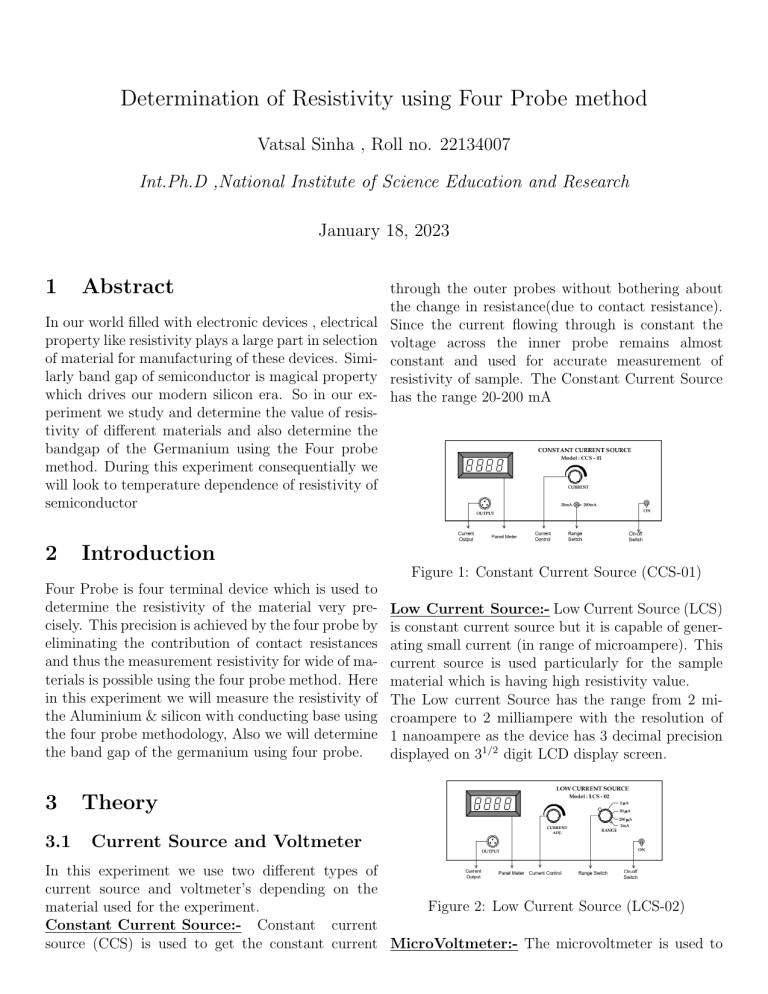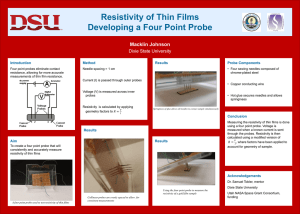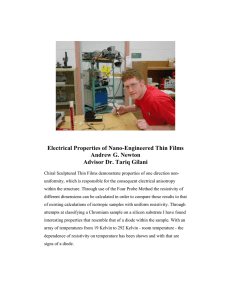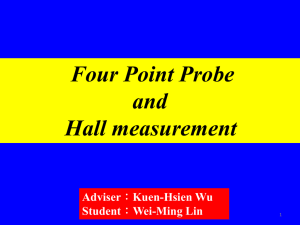
Determination of Resistivity using Four Probe method Vatsal Sinha , Roll no. 22134007 Int.Ph.D ,National Institute of Science Education and Research January 18, 2023 1 Abstract In our world filled with electronic devices , electrical property like resistivity plays a large part in selection of material for manufacturing of these devices. Similarly band gap of semiconductor is magical property which drives our modern silicon era. So in our experiment we study and determine the value of resistivity of different materials and also determine the bandgap of the Germanium using the Four probe method. During this experiment consequentially we will look to temperature dependence of resistivity of semiconductor 2 through the outer probes without bothering about the change in resistance(due to contact resistance). Since the current flowing through is constant the voltage across the inner probe remains almost constant and used for accurate measurement of resistivity of sample. The Constant Current Source has the range 20-200 mA Introduction Figure 1: Constant Current Source (CCS-01) Four Probe is four terminal device which is used to determine the resistivity of the material very precisely. This precision is achieved by the four probe by eliminating the contribution of contact resistances and thus the measurement resistivity for wide of materials is possible using the four probe method. Here in this experiment we will measure the resistivity of the Aluminium & silicon with conducting base using the four probe methodology, Also we will determine the band gap of the germanium using four probe. 3 3.1 Low Current Source:- Low Current Source (LCS) is constant current source but it is capable of generating small current (in range of microampere). This current source is used particularly for the sample material which is having high resistivity value. The Low current Source has the range from 2 microampere to 2 milliampere with the resolution of 1 nanoampere as the device has 3 decimal precision displayed on 31/2 digit LCD display screen. Theory Current Source and Voltmeter In this experiment we use two different types of current source and voltmeter’s depending on the Figure 2: Low Current Source (LCS-02) material used for the experiment. Constant Current Source:- Constant current source (CCS) is used to get the constant current MicroVoltmeter:- The microvoltmeter is used to measure the voltage between the inner two probes in order to determine the resistivity of the sample material. Microvoltmeter is required as the current flowing through the sample is ranging from few nanoampere’s to hundred’s of milliampere depending on the sample. So this versitile voltmeter is used as range knob of voltmeter reads from 1mV to 10V with the resolution of microvolts. Figure 3: Digital Microvoltmeter PID Controller :- The term PID stands for proportional integral derivative and it is one kind of device used to control different process variables like pressure, flow, temperature, and speed in industrial applications. In this controller, a control loop feedback device is used to regulate all the process variables. With the use of a low cost simple ON-OFF controller, only two control states are possible, like fully ON or fully OFF. It is used for a limited control application where these two control states are enough for the control objective. However oscillating nature of this control limits its usage and hence it is being replaced by PID controllers. • P-Controller:-Proportional or P- controller gives an output that is proportional to current error e (t). It compares the desired or set point with the actual value or feedback process value. The resulting error is multiplied with a proportional constant to get the output. If the error value is zero, then this controller output is zero.This controller requires biasing or manual reset when used alone. This is because it never reaches the steady-state condition. It provides stable operation but always maintains the steady-state error. • I-Controller:-Due to the limitation of pcontroller where there always exists an offset between the process variable and setpoint, Icontroller is needed, which provides necessary action to eliminate the steady-state error. It integrates the error over a period of time until the error value reaches zero. It holds the value to the final control device at which error becomes zero.ntegral control decreases its output when a negative error takes place. It limits the speed of response and affects the stability of the system. • D-Controller:-I-controller doesn’t have the capability to predict the future behavior of error. So it reacts normally once the setpoint is changed. D-controller overcomes this problem by anticipating the future behavior of the error. Its output depends on the rate of change of error with respect to time, multiplied by derivative constant. It gives the kick start for the output thereby increasing system response. Response of D, the controller is more, compared to the PI controller, and also settling time of output is decreased. It improves the stability of the system by compensating for phase lag caused by I-controller.So finally we observed that by combining these three controllers, we can get the desired response for the system. PID controller maintains the output such that there is zero error between the process variable and setpoint/ desired output by closed-loop operations. 3.2 Four Probe Arrangement The arrangement consists of four equally spaced collinear probes. These probes are attached to spring load so that excess load do not damage the sample. The probes are mounted in a teflon bush, which ensure a good electrical insulation between the probes. A teflon spacer near the tips is also provided to keep the probes at equal distance. The probe arrangement is mounted in a suitable stand, which also holds the sample plate and RTD sensor. This stand also serves as the lid of PID Controlled Oven. Proper leads are provided for current, Voltage & Temp. measurement with their universal connectors. For current measurement there is three pin connector which can be connected to the CCS-01/ LCS-02 as per requirement of sample. For voltage measurement BNC connector is used connected to DMV-001 unit. For temperature measurement, a two pin connector is provided for connection with PID- Controlled oven unit PID-200 at connector marked as Temperature Sensor. 1. The resistivity of materials in area of measurement is uniform 2. There is no injection of minority charge carriers in the semiconductor due to current flowing throught four probe 3. The surface on which the probes rest is flat with no surface leakage. 4. The distance between probes of four should be equal and they should collinear. 5. Diameter of the four probe contact should be small compared to the distance between the probes. Figure 4: Four Probe Arrangement Three levelling screws are provided in Four Probe arrangement by which we can adjust the level of plateform to make it horizontal. A probe holding screw is provided at the collar of the arrangement. Initially it should be in loose position, to allow free movement of Probe Pipe. After placing the sample the Probe Pipe should be lowered so that all four pins touches the sample. Further Press the pipe very lightly so that the assured firm contact is made of all Four Pins with the sample. Tighten the Probe Holding Screw at this position. The Probe Arrangement is ready with the sample for the experiment. 6. Surface of the material can be conducting or non-conducting 3.4 Resistivity Measurement of the large sample From the design of the four probe the diameter of probes is very small compare to that of distance between the probes so we can consider that the probes are far away from any other surfaces of the sample and we assume semi-infinite volume of uniform resistivity material[fig]. Four probes are spaced S1 ,S2 and S3 apart. Current I passes through the outer probes(1 and 4) and the floating potential is measured across the inner pair of probes 2 and 3. The floating potential Vf a distance r from an elec3.3 Working of Four Probe trode carring a current I in a material of resistivity Four probe contains of four terminals which are ρ0 is given by placed on the surface of the sample. The outer two ρ0 I Vf = probes are used to pass the current by using the DC 2πr constant current source and remaining two probes In the fig- there are two current carrying electrodes, are used measure the potential difference with the 1 and 4, and the floating potential V ,at any point f help of millivoltmeter. So here we can see that the Y in the semiconductor is the difference between the use different probe for measuring the voltage and potential induced by each of the electrode, since they current eliminates the contribution from the contact carry currents of equal magnitude but in opposite resistance as the contact resistance will be experi- direction thus: enced by the probes used for passing current and since current is not used in calculating the resistivρ0 I 1 1 Vf = − (1) ity, thus the value of resistivity becomes independent 2π r1 r4 of contact resistance. Now while using the Four probe for measurement we where r1 = distance from probe number 1 and r4 = have to make some assumptions. These assumptions distance from probe number 4. The floating potentials at probe 2, Vf 2 and at probe are : 3, Vf 3 can be calculated from (1) by substituting the The resistivity then becomes proper distance as follows: ρ0 ρ= (6) G6 ( W ) 1 ρ0 I 1 S − Vf 2 = 2π S1 S2 + S3 where resistivity ρ0 is computable from (2 and 3) can be used if the point spacing are different, but ) is comapproximately equal. the function G6 ( W S ρ0 I 1 1 puted from Vf 3 = − 2π S1 + S2 S3 ∞ The potential difference V between probes 2 and 3 1 W S X 1 G6 =1+4 (−1)n − r r 2 2 S W n=1 is then S S 2 2 + (2n) 2W + (2n) W ρ0 I 1 1 1 1 (7) V = Vf 2 −Vf 3 = + − − 2π S1 S3 S2 + S3 S1 + S2 3.6 and the resistivity is given as V I ρ0 = 2π 1 S1 + 1 S3 − 1 S2 +S3 1 S1 +S2 − (2) Resistivity Measurement on a Thin Slice-Non-Conducting Bottom Surface In this case we will the process as case , except the When the point spacings are equal, that is, bottom surface of the slice is nonconducting. This S1 = S2 = S3 = S the equation written above means that all the images of figure 3 have the same simplifies to : charge as the current source. Thus all the images on a row have equal charges and eq.5 describes the potential difference between inner probes, if (−1)n V (3) is removed from the equation. Then, ρ0 = × 2πS I 3.5 Resistivity Measurement of the bottom conducting surface In this case thin film of conducting material is deposited on to the silicon wafer thus forming the boundary in between the conducting thin film and non-conducting silicon wafer.Therefore, we have two boundary condition and these boundaries are parallel and thus the solution is taken by using the method of images. In this solution each current source has infinite series of images along a line normal to the plane and passing through the current source. The model for this case is shown in Fig. 9. The side surface of the slice is assumed to be far from the area of measurement and, therefore, only the effect of the bottom surface needs to be considered. In this analysis equal probe spacing S shall be assumed. The width of the slice is W. The array of images needed is indicated in Fig. 9. where the polarity and spacing of the first few images are as shown. The floating potential Vf2 at electrodes 2 is ρ0 G7 ( W ) S ρ= (8) where ∞ S X r G7 (W/S) = 1 + 4 W n=1 S W 1 2 1 − r 2 S + (2n)2 2W + (2n)2 (9) For smaller values of W/S the function becomesG7 = 2S loge 2 W (10) for a typical sample W/S ¡0.25 the correction factor can be obtained from equation(10) directly. 3.7 Determination of Band Gap of Germanium In figure four probes are spaced S1, S2, S3 and S4 apart. Current I is passed through the outer probes 2π n=−∞ S 2 + (2nW )2 (2S)2 + (2nW )2 n=−∞ (4) (1 & 4) and the floating potential V is measured Likewise, the floating potential at electrode (3) can approx the inner pairs of probes 2 & 3. The potetial be given by difference between 2& 3 can given by " # Vf 2 = ρI V = Vf 2 = ∞ X ρI 1 2π S 1 n (−1) + ∞ X − p 1 n (−1) n=1 p S 2 + (2nW )2 ∞ X − ∞ X p 4 n (−1) n=1 4 n (−1) p (2S)2 + (2nW )2 (5) V = Iρ0 2πs Where ρ0 is the resistivity of the material, I is 5 Graph the amount of current passing through the material. Therefore, 5.1 Resistivity for Silicon V ρ0 = 2πs S=0.2± 2% cm I G7 (W/S)=5.545[from eq(10) ] Since the thickness of the crystal is very small compared to the probe distance a correction factor for it has to be applied. ρ= ρ0 ρ0 = G7 f ws Now substituting the values, V V = 1.256 I I and the correction factor G7 i.e. f ws is 5.89 ρ0 = 2 × 3.14 × 0.2 × Figure 5: Graph 1: Voltage vs Current for silicon 1.256 V ρ0 = 5.89 5.89 I V ρ = 0.213 I ρ= ∴ 5.2 Resistivity of Germanium Thus ρ may be calculated for various temperatures. 1 Now, if we plot log10 ρ vs. , we get a curve which is T linear at higher temperatures. We know resistivity, Eg ρ = C exp , where C is a constant. From 2KT Eg 1 + ln C this expression we can have: ln ρ = 2K T Therefore, width of the energy gap may be determined from the slope of the linear portion of the experimental curve: Figure 6: Graph 2 : Voltage vs Current for germanium ∆ log10 ρ ∆ ln ρ 1 Eg = = × 1 1 2.303 2K ∆ 2.303 × ∆ T T Thus we have Eg = 2.303 × 2K 4 ∆ log10 ρ 1 ∆ T (11) Apparatus PID Controller, Constant Current Source, Low current source, Four Probe, Silicon , Germanium , Oven, Microvoltmeter, Four Probe stand 5.3 Resistivity of Alumunium Figure 7: Graph 2 : Voltage vs Current for alumunium 5.4 Temperature Dependence of Resistivity of Germanium Figure 8: Graph 3 :Temperature dependence of resistivity of Germanium 6 6.1 Calculations let slope = m ∴ For Silicon ρ= mπW loge 2 From the graph 1 we get the slope = 136.2 and thus using the value to calculate the resistivity ρ0 & ρ, Now Error in resistivityThus we get, ρ0 = Slope of graph 1 ×2πS=171.15×2π × s 2 2 0.2=130.898 Ω.cm ∂ρ ∂ρ ∆ρ = ∆m + ∆W ∴ Corrected resistivity of Si is=171.15/5.545= ∂m ∂W 30.866 Ω.cm (12) (13) ∴ 6.2 For Germanium From the graph 2 we get the slope = 86 and thus using the value to calculate the resistivity ρ0 & ρ, Thus we get, ρ0 = Slope of graph 1 ×2πS=86×2π × 0.2=108.07 Ω.cm ∴ Corrected resistivity of Si is=108.07/5.545= 19.48 Ω.cm 6.3 For Alumunium s ∆ρ = πW ∆m loge 2 2 + mπ ∆W loge 2 2 (14) For si ∆m = 0.135Ω.cm, ∆W = 2% × 0.05cm=0.001cm ∴ ∆ρ for si =0.473 Ω.cm For Ge ∆m = 0.061Ω.cm , ∆W = 2% × 0.05cm=0.001cm For Al ∆m = 0.0002Ω.cm , ∆W = 2% × 0.05cm=0.0001cm From the graph 2 we get the slope = 0.0003 and thus using the value to calculate the resistivity ρ0 & From Eq. 14 ∆ρ for ge =0.355 Ω.cm ρ, Thus we get, ρ0 = Slope of graph 1 ×2πS=0.0003×2π × Now we know band gap 0.2=0.00188 Ω.cm log ρ ∴ Corrected resistivity of Si is=0.00188/5.545= Eg = 2k 1e T 0.681×10− 6Ω.cm 6.4 Band gap of Germanium From the graph 3 we found that the slope of graph is 3822.5, Thus using equation 11 to find the band gap energy of the germanium , thus we get, Eg = ∆ log10 ρ 2.303 × 2K 1 ∆ T so Eg = 2k × slope of graph = 2 ∗ 8.6 ∗ 10−5 ∗ 3822.5 ⇒ 0.657eV 7 Error Analysis We know that from Eq (8) ρ0 2πS ρ= =(slope of V vs I graph)× 2S W G7 ( S ) loge 2 W Slope × π × W ρ= loge 2 ⇒ Eg = 2KB × (slope of graph 3) ⇒ ∆Eg = 2KB × ∆slope (graph-3)=0.0078 eV 8 Result and Conclusion From this four probe experiment we successfully determined the value of resistivity of different materials and band gap energy of germanium with high degree of precision. 1. The experimentally measure value of resistivity of silicon is, ρSi = 23.606 ± 0.473) Ω.cm. 2. The experimentally measure value of resistivity of Germanium 17.73 ±0.355) Ω.cm. 3. The experimentally measure value of Bandgap of Germanium is,Eg = (0.7022 ± 0.0078)eV. 9 Source of Error 1. Material (Al) used in the foil is commercial grade, while standard resistance is for pure Al. 2. The thickness of Al foil is very small and thus prone to non-uniformity in thickness 3. Variation of doping can affect the result of the experiment 4. The resistivity of used cross section can show non-uniformity 10 Precautions • Probes are sharp so minimal pressure should be applied so that it does not damage sample. • The oven need to be given some amount of time to achieve constant temperature. • The electrical connection should not be loose. • The probes should be at equal heights • The probe pipe need to be stable and probes need to be as sharp as possible 11 References • https://www.iiserkol.ac.in/~ph324/ ExptManuals/ResistivityFourProbe.pdf • https://www.pveducation.org/ pvcdrom/characterisation/ four-point-probe-resistivity-measurements • https://www.ossila.com/pages/ sheet-resistance-measurements-thin-films




